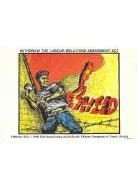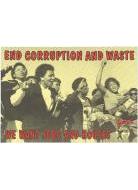The people must decide!
We have had enough of corruption
We have had enough of state sponsored violence and death squads!
The people must decide - the murderers and crooks!
It is time for a new, honest, democratic government!
- COSATU pamphlet, Mass Action, date unknown.
Despite the intense repression of the state in the late 1980s, which included mass detentions, the restriction of political activity and a ban on all media activity, the state had not been able to crush resistance. 1989 saw a strong revival of anti-apartheid activity. It began with the detainees in jails across the country embarking on a hunger strike. This led to the government releasing a large number of these detainees, largely to avoid an international outcry. This inspired further resistance to the state.
The UDF began to strengthen its political alliances and formed an alliance with COSATU, which came to be known as the Mass Democratic Movement (MDM). The MDM was a broad coalition of anti-apartheid forces within South Africa which were committed to a non-racial, democratic South Africa. Not everyone agreed with this approach to the struggle. Some trade unions, in particular, the National Union of Metalworkers (NUMSA), supported a socialist alternative and believed that workers needed to overthrow both apartheid and capitalism. Black Consciousness leaders also rejected a broad anti-apartheid alliance.
In August 1989 the MDM embarked on a massive Defiance Campaign. The aim was to mobilise people against the segregation laws of apartheid. Thousands of people started to engage in acts of civil disobedience. They broke the laws by going into segregated public places and defied the restrictions imposed on them by the State of Emergency. The Defiance Campaign ended with mass protests against elections to the Tricameral Parliament. A number of mass marches took place. In Cape Town about 50,000 people marched against security police actions. There were marches by workers against the Labour Relation Act. In Johannesburg, about 25,000 people marched against racial repression and racial segregation. This sustained resistance andpressure on the government was known as rolling mass action.
The new president, F.W. de Klerk, urged police to behave in a restrained way. At this time, the government was involved in secret talks with the ANC about negotiations. It was also facing intense pressure from the outside world. International companies had disinvested, there were economic sanctions placed on South Africa. The South African economy was in a very vulnerable position. De Klerk recognised the need for change.
The Defiance Campaign had shown the South African state that it was possible to resist apartheid and bring about change. Very shortly after the Defiance Campaign, F. W. de Klerk unbanned the ANC and other political organisations, and released Nelson Mandela from prison.
There can be no doubt that workers played a significant role in bringing about the end of apartheid. In the late 1980s, COSATU emerged as a driving force in the mass protests that rocked the country. During the 20th century, the trade union movement had come a long way, in fighting for workers’ rights, in forging unity between the different trade union groupings, and in challenging the apartheid regime.
Have these achievements been sustained in the 21st century? The trade union movement was weakened when the country moved towards democracy. Many of the leaders in the union movement abandoned the trade unions and took up positions in government. With COSATU in an alliance with the government, one must question how effective it is as a trade union federation which often has to challenge conditions in the public sector. Cracks in unity are also beginning to emerge as NUMSA talks about breaking away and the giant mining union, NUM is ruptured by a breakaway union. If one is to sustain a strong trade union movement in South Africa, these issues need to be addressed.
Exhibitions in the classroom
Visualising the past:
Source: COSATU/NACTU march to protest against the Labour Relations Act (LRA). JHB. Oct. 1989.
Look at the photograph from one of the marches during the Defiance Campaign.
• How many different organisations can you identify in the photograph?
• What does this large number of different organisations suggest about the Mass Democratic Movement?
• What feelings does this photograph make you feel? Explain your answer.







